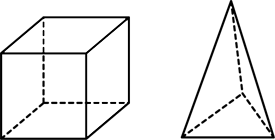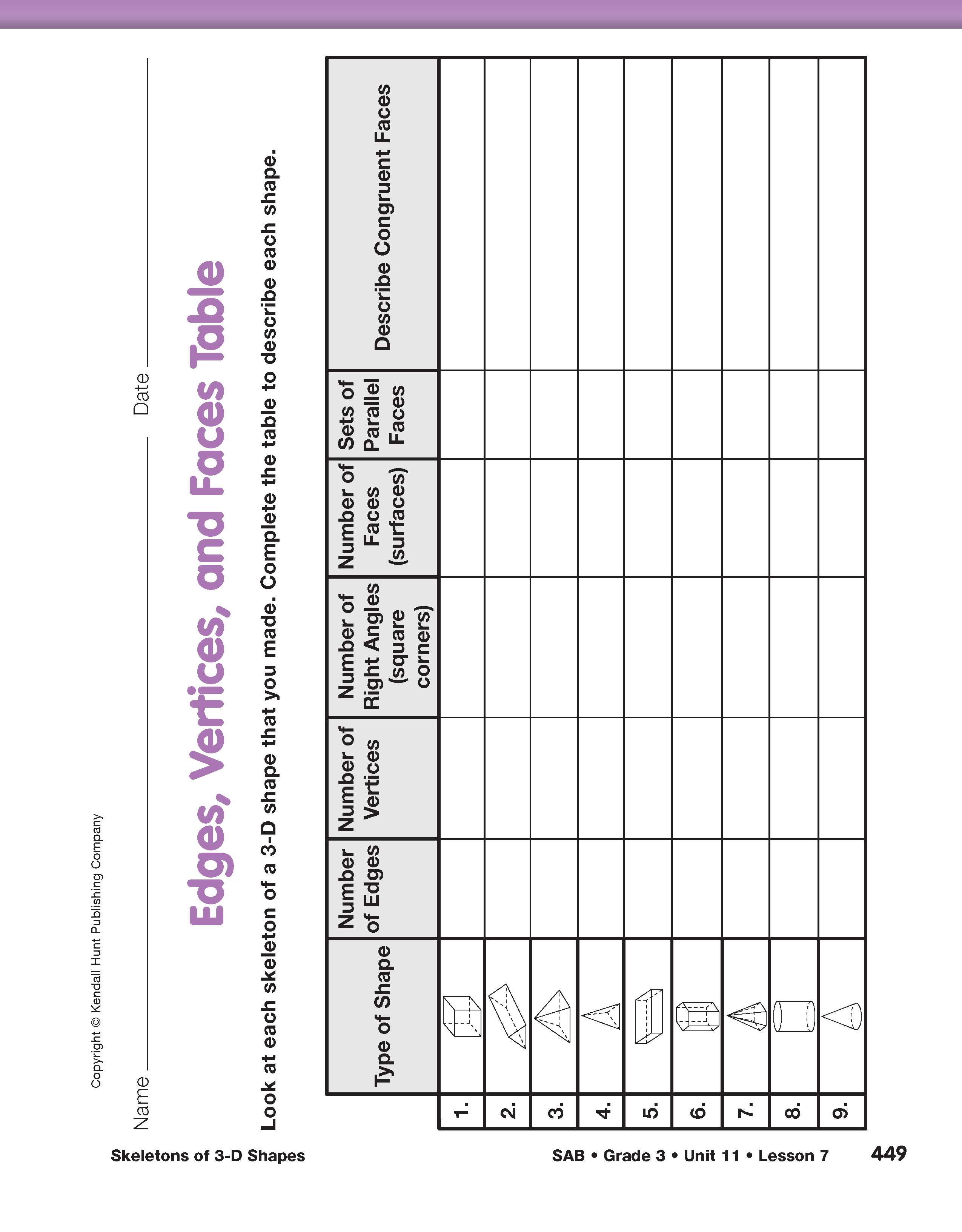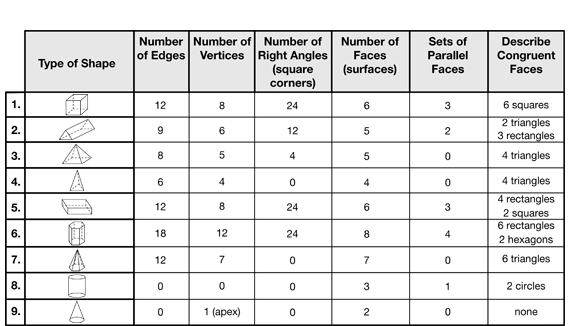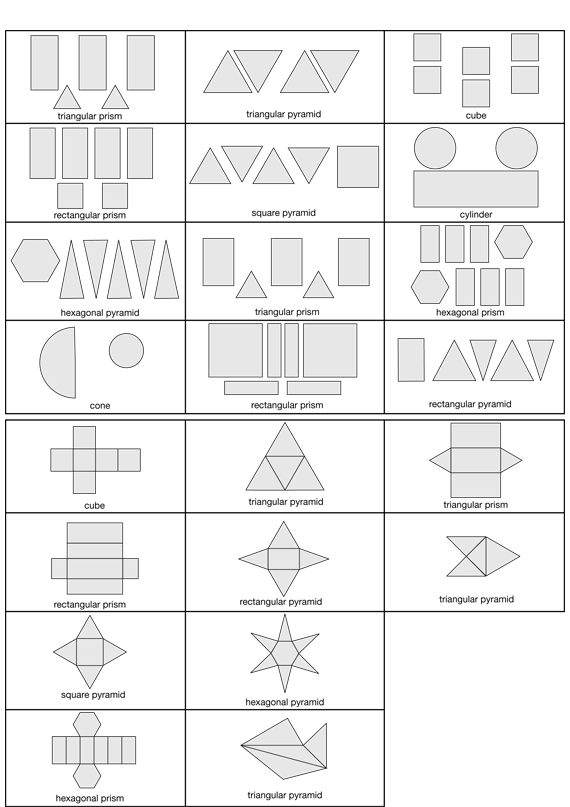Focus on Faces of 3-D Shapes. Display a skeleton of one of the three-dimensional shapes students constructed in the previous lesson. Briefly review the terms edge and vertex (vertices).
- What was missing on the skeletons of 3-D shapes we made? (the faces)
Tell students that they are going to trace the faces of three-dimensional shapes then play a game to identify the shape by its faces and properties. Select one shape from the set of Power Solids® and show students how to trace each face leaving space between each. Each face should be shown, even if congruent to other faces. For example, a tracing of the cube should display six congruent squares. Color each face with the same color to help draw student's attention to the shape of each face. See the Faces of 3-D Shapes Cards Masters for examples.
Display and focus students' attention on a cube, a rectangular prism, sphere, cylinder, and cone from the set of Power Solids®.
- Look at these shapes. Which do you think would be difficult to trace? Why? (Possible responses: The sphere because I am not sure what to trace or where to start and stop tracing; the cylinder and cone because the curve is hard to trace.)
- Does a sphere have a face to trace? (It has a surface but I am not sure what to trace. I am not sure it has a face.)
- Does a cylinder have a face to trace? (Possible response: Yes, two circles but I am not sure how to trace the curved part or if the curved part is called a face.)
- Does a cone have a face to trace? (Possible response: Yes. I have made party hats. The cone just needs to be flattened; I am not sure where to start and stop because it is curved.)
- Who would like to trace the faces of the cylinder?
- Who would like to trace the faces of a cone?

Faces, edges, and vertices. For this unit, students will blend everyday language with mathematical language to define properties and types of objects in space.
The easiest objects to describe are the polyhedra. A polyhedron is a connected three-dimensional shape whose surface is made of polygons. Each polygon meets exactly one other polygon along a common edge. The polygons that make up the surface are called faces. The edges meet at points called vertices. For example, a cube is a polyhedron that has 6 faces, each of which is a square. A triangular pyramid is a polyhedron that has 4 faces, each of which is a triangle. It should not be too hard for students to correctly identify vertices, edges, and faces of polyhedra.

Vertices, edges, and faces can also be defined for certain three-dimensional objects that are not polyhedra. In that case the definitions can get quite technical, so we rely on everyday language for discussing the properties of objects like spheres, cones and cylinders. Deciding on definitions helps students see the connections among shapes and their properties.
Every point on a sphere is the same distance from a point called the center. Because a sphere is not a polyhedron, it does not make strict mathematical sense to talk about its faces, vertices, and edges. An ordinary sphere does not have edges or vertices, but students may decide that it has one face. The central idea, which may be difficult for students to verbalize, is that faces are two-dimensional (i.e., surfaces), edges are one-dimensional (i.e., lines or curves) and vertices are 0-dimensional (i.e., points).
Cones are shapes with a base and all points on the base connected to a top vertex. The base may be any shape. Using this definition, all pyramids are special cones. A circular cone has a base in the shape of a circle.
Cylinders are shapes with two congruent and parallel faces. Moreover, lines joining the corresponding points on the two bases are always parallel. All prisms are special kinds of cylinders. A circular cylinder has two congruent and parallel circles as bases.
One possible approach that students might come up with is to decide that faces are the flat side of a solid. In that case, for example, a cylinder will have two faces. Other students may think of faces as surfaces separated by edges. In that case, a cylinder would have three faces. A third way students might define the faces of a solid would be the parts of the surface separated by edges. In that case, a cylinder would have three faces and a cone would likely be considered to have two faces. Finally, there are some special cases such as the sphere. Again, since we don't want to get too technical, the class can decide whether the sphere has one face or none.
To sum up, the goal of this lesson is to get students thinking about properties and classification of three-dimensional shapes. So for shapes that are not polyhedra, we rely on definitions using everyday language that the students arrive at by consensus.
Help students decide if the curved surface on the cone, cylinder, and sphere are considered a face of the shape. It all depends on how face is defined. See the Content Note.
Encourage students to use words and descriptions from the Properties of 3-D Shapes chart made and displayed during Lesson 6 as they discuss and compare the shapes. Present the cones and cylinders as a challenge, and explain that these shapes will be more difficult to trace. Having students think about how to cover the cone and cylinder may help them figure out what these faces look like.
Trace Faces of Power Solids®. Distribute the sets of Power Solids® you prepared, drawing paper, and some crayons to each pair of students. Provide time for student pairs to trace their assigned shapes. Tell students to trace each face so that the number of traced faces equals the number of faces on the solid. One partner can hold the first three-dimensional shape firmly in place while the other partner traces. See Meeting Individual Needs. Ask students to color and label their tracing with the name of the shape for a display. If they do not know the name this will provide an opportunity later in the lesson to discuss properties and how a shape is named. As students finish, post at least one example of each shape where it is visible for all to see.

To ensure all students successfully trace the faces of a shape, distribute more complex shapes to students with developed fine motor skills. A larger model of a shape (e.g., tissue box) traced on large paper may also be easier for some students. If students are having difficulty with one-to-one correspondence between the faces and the traced shapes, have them cut out the shapes and tape them to the solid or label each face and shape with the same number.
As students work on tracing the three-dimensional shapes, note their varying approaches for completing this task. For example, some students may decide to trace one face several times if the faces of their particular shapes are the same. Another student may systematically trace the shape of each face while others will draw one of each type of shape. If a student pair finishes early, give them another three-dimensional shape to trace.
Manipulating and describing three-dimensional objects helps students identify characteristics of geometric solids. Circulate through the classroom as students are working asking them to describe the shapes they traced. Below are some students' descriptions:
Student A
I traced rectangles and triangles from my triangular prism. There are 5 faces and 6 vertices.
Student B
This is a rectangular prism. It has 6 faces. Two faces on the sides are matching. The front and back faces are matching. The top and the bottom faces are matching. The faces are rectangles.
When tracings are complete, ask:
- If shortcuts were allowed, were there any you could have used when tracing? (Yes, congruent faces could be traced only once.)
- How would you know the total number faces the shape has? (We could just label how many of that face on the paper, like trace one square for the cube and write a 6 in it.)
- Which method makes it easier to identify the shape? Why? (Tracing all the faces, because you can picture the shape in your head and put the faces together to find the shape more easily.)
Have the student pairs who worked with the cylinders and cones explain to the class any problems they encountered while trying to cover these shapes. For example, one student traced the top and bottom of her cylinder and then kept experimenting until she was able to trace the curved surface of the cylinder. She explained her procedure to the class:
Student C
I put the cylinder down on the paper, and made the top and bottom. I rolled the can, and I kept tracing the top and bottom. When I thought the paper would go around, I cut it out. But I had to make another and another because the paper didn't fit. When it fit, I traced the cut out.
The faces or surfaces of the cone and cylinder can be challenging for students to visualize. Some students will roll the shape as they trace the curved face. If students are not able to describe these faces, identify a cone and cylinder as an everyday object (e.g., party hat, oatmeal container) and cut apart the curved face and flatten out the face to reveal the shape. Another way to visualize the faces of a cylinder is to ask students to roll up a sheet of notebook paper. Ask:
- What shape is the notebook paper? (rectangle)
- What shapes are the faces of the cylinder? (a rectangle and two circles)
Describe Faces of 3-D Shapes. As students complete the tracing, ask them to count the number of faces, parallel faces, and the number of congruent faces on the shapes they traced. Students should complete the appropriate rows and columns of the Edges, Vertices, and Faces Table page from the Student Activity Book that they partially completed in Lesson 7. See Figure 2. As students finish their analysis, ask some students to complete the display version of the same chart you prepared and to post at least one example of face tracings where it is visible for all to see. Ask students to use the information in the displayed table to complete their own table. Students will refer to the information in this table in the next lesson.
Label Names on Tracings of 3-D Shapes. Students may not know the names of some of the shapes that were traced, as they have not yet encountered them in this unit. Ask students to match the solid from the classroom set to the tracings and verify the name of the three-dimensional shape.
If the name of a shape is unknown, using the hexagonal pyramid as an example, conduct a discussion using questions similar to the following:
- How many faces do you see? (seven)
- What is the shape of each face? (There are six triangles and one hexagon.)
- Which face is the base? (the hexagon)
- How are the triangular faces joined? (They meet at the top at a vertex.)
- Which shapes have faces that meet at one top vertex? (a pyramid)
- What do you think this shape is called? (a hexagon pyramid or hexagonal pyramid)
Once all tracings have been labeled with the correct name and the display of the Edges, Vertices, and Edges Table is complete, continue the lesson with the Guess My Shape game.
Play Guess My Shape. Display the Faces of 3-D Shapes Cards Masters you prepared and challenge students to identify each shape. These masters either display the faces of shapes scattered or organized to form a net. A net is a pattern that can be cut and folded to make a model of a solid shape. Since these cards are similar to the tracings students already completed and have displayed, start the game by showing them the cards with the scattered faces.
- What shape is this? Choose the model from the collection to show what shape I am showing.
- How did you decide?
- How do you know?
Continue playing the game with the cards that show the nets of shapes. Some cards are close representations of the Power Solids® and others do not match the Power Solids®. Students should use the properties of shapes to justify their thinking.
- Which type of shape am I showing?
- How are faces similar to the Power Solids® we traced?
- How are the faces different?
- How did you decide which shape I am showing?
Yet another way to play the game is to display the shapes on a card revealing one at time until the shape is guessed. For example, show the card with the faces of the square pyramid scattered.
- [Show a triangle.] What shape might I be showing? (the square pyramid, rectangular pyramid, triangle pyramid, triangular prism)
- [Show two triangles.] What shape might I be showing? (the square pyramid, rectangular pyramid, triangle pyramid, triangular prism)
- [Show two triangles and a square.] What shape might I be showing? (the square pyramid or the triangular prism)
- Why am I not showing the other shapes? (Possible response: The rectangle pyramid does not have a square face; the triangle pyramid has all triangle face.)
- If I am showing a triangular prism, what shape will I show next? (another square)
- If I am showing a triangular pyramid, what shape will I show next? (another triangle)
Play Guess My Shape with a few other shapes.

















